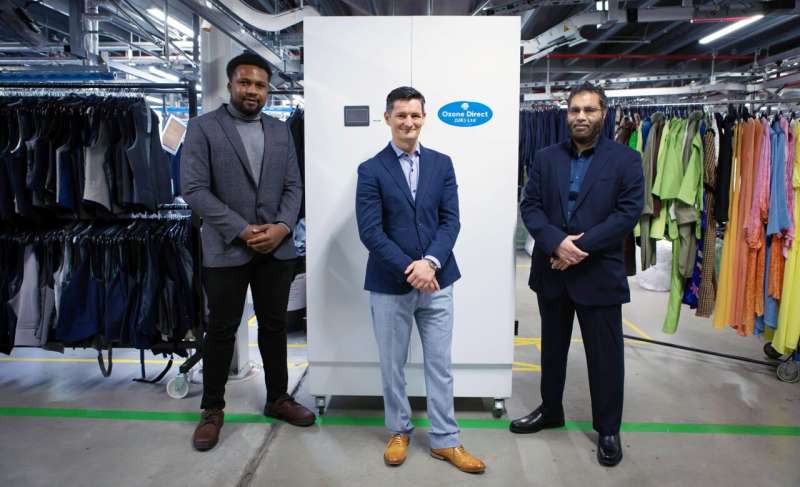
An eco-friendly technology that effectively sanitizes clothing could help protect the environment by dramatically slashing waste, researchers believe. They have published their results in Ozone: Science & Engineering.
The patented technology—created by University of the West of Scotland (UWS) and Advanced Clothing Solutions (ACS)—was initially developed to disrupt “fast fashion,” through offering retailers and brands an alternative, environmentally friendly solution for sanitizing used clothing and accessories.
Scottish Enterprise will financially support the project, which will bolster ambitions through supporting the development of a state-of the-art “sanitization chamber”—designed by researchers at UWS. The chamber will be installed at ACS’s automated fashion fulfillment facility on the outskirts of Glasgow.
Dr. Mohammed Yaseen, of UWS’s School of Computing, Engineering and Physical Sciences, says that “this revolutionary technology has real potential to disrupt the fashion and textile industry and offers huge environmental benefits, which could see a significant reduction in landfill waste from clothing.”
After rigorous trials the system has been shown to effectively kill a vast range of germs and viruses, such as E. coli, S. aureus and coronavirus, which can remain on clothing and fashion accessories. It is now being successfully trialed on PPE, making it safe to reuse, which could significantly reduce environmental waste from PPE products.
Anthony Burns, Chief Operating Officer of ACS Clothing, says that “at ACS, we are known for helping retailers to grow their sustainable and circular fashion ambitions by providing a complete rental and resale service, managing the entire process from our purpose-built facility. However, introducing circularity and reuse of PPE has presented an interesting but not insurmountable environmental opportunity.”
“Every piece of PPE presents a sustainability and recycling challenge. Many items were initially deemed single-use because knowledge of sterilizing these items wasn’t available. With sterilization technology, we hope to reverse much of this single-use problem. We are delighted to have put our partnership with UWS to good use to help develop revolutionary eco-friendly sterilization technology that can drastically reduce landfill waste from clothing, textiles, and PPE products.”
Dr. Yaseen added that “the eco-friendly solution uses ozone gas to decontaminate fabrics, which subsequently helps to reduce the use of water and avoid negative environmental impacts from detergent use.”
“The success of the project is undoubtedly due to the strong partnership between UWS and ACS, initiated through Innovate UK’s Knowledge Transfer Partnership (KTP) program. Our KTP Associate, Dr. Emmanuel Epelle, has been central to the project’s success.”
Glasgow-based ACS prolong the life of used or damaged garments for some of the country’s biggest brands, through their sustainable textile repair, refurbishment, and cleaning service.
Forty percent of clothing purchased online is returned, with less than half of it being resold and the remainder ending up at landfill sites, or being burned. Through extending the lifetime of a garment by three months, its carbon footprint is reduced by 10% and a pre-owned purchase, or a rented garment, saves 1kg in waste, 3,040 liters of water, and 22kg CO2. ACS clean around 45,000 garments each week.
More information: Emmanuel I. Epelle et al, The Impact of Gaseous Ozone Penetration on the Disinfection Efficiency of Textile Materials, Ozone: Science & Engineering (2022). DOI: 10.1080/01919512.2022.2066503
Citation: Is the global fashion industry about to be revolutionized by a new sanitization technology? (2022, June 6) retrieved 6 June 2022 from https://techxplore.com/news/2022-06-global-fashion-industry-revolutionized-sanitization.html
This document is subject to copyright. Apart from any fair dealing for the purpose of private study or research, no part may be reproduced without the written permission. The content is provided for information purposes only.

